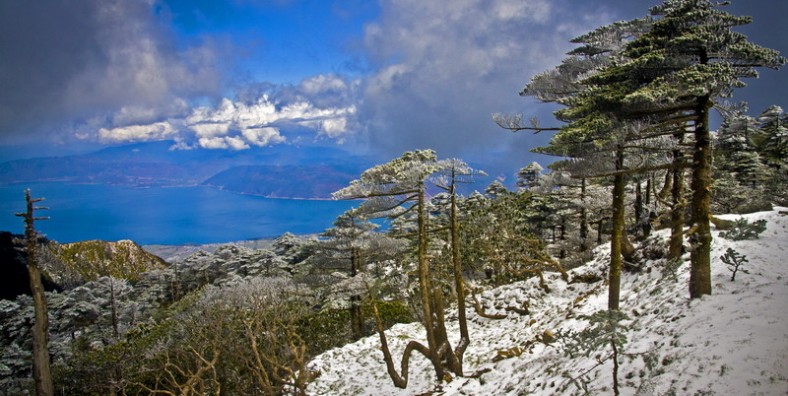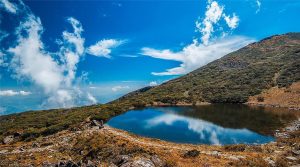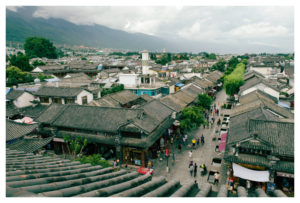 alt="Puer Surrounding Counties and Towns: Weekly & Special Local Markets Travel Guide"
/>
alt="Puer Surrounding Counties and Towns: Weekly & Special Local Markets Travel Guide"
/>
Cangshan Mountain, Dali

Chinese Name: 苍山
English Name: Cangshan Mountain
Type: Mountain, Nature & Geological Park
Best Seasons: Spring and Autumn, especially from March to May when the azalea blossoms
Popular Activities: hiking, photography
Recommended Visiting Hours: about 3 hours
Opening Hours: 08:30~16:10 for April to October; 08:30~15:40 for November to next March
Ticket: 30 Yuan for Entrance Ticket Fee; 282 Yuan for Ximatan Cableway round trip, 80 Yuan for Gantong Cableway round trip, 90 Yuan for Zhonghe Cableway round trip
Location: 2 km in the west of Dali Old Town in Dali Bai Autonomous Prefecture
Cangshan Mountain
Cangshan Mountain lies west of Dali Ancient City and Erhai Lake and includes 19 peaks and 18 streams. Mt.Cangshan’s 19 peaks extend 50km north to south in their column formation like a screen. The highest peak is Malong Peak with the height of 4,122 meters (13,524 feet). Waterfalls and surging rivers emit thunderous roars. Malongfeng, the main peak, shoots up into the sky with its top clogged with dazzling snow all the year round. ‘Clouds, Snow, Peaks and Streams’ are four spectacular views of the Mountain. May and June are the perfect months to visit Cangshan Mountain since at that time it’s carpeted with many kinds of flowers. The azaleas are the most eye-catching.
Why is Cangshan Mountain so special?
Cangshan Mountain is a high mountain rising above the city of Dali in the southern province of Yunnan that borders Vietnam. It is a scenic spot and a good hiking area where hikers may bring tents. It is said that the snow will not melt even in the hottest days of summer. The Snow, one of the renowned 4 top scenes (the Wind, the Flower, the Snow and the Moon) in Dali City, refers to the amazingly beautiful unmelted snow scene on Cangshan Mountain. Mist often lays over the snow capped mountain peaks, which gives visitors an impression of mistery and magnificence. The mountain is a highlight of the Dali area, with numerous springs, ponds and waterfalls, beautiful scenery, hiking trails, a range of ecological zones with thousands of plant species, and scenic views of lakes and the city of Dali.
Where is Cangshan Mountain?
Cangshan Mountain is situated in the west of Dali Old Town and Erhai Lake. It is very popular to get from Dali Old Town to Cangshan Mountain either by bus, bike or walking.
Distance from other famous attractions in Dali
- About 1.9 km from Dali Old Town
- About 2.6 km from Three Pagodas of Dali
- About 6 km from Erhai Lake
- About 25.7 km from Shuanglang
How to Get to Cangshan Mountain?
There is tourism cableway in Mt. Cangshan. Next station is located in west of a racetrack in Dali March Street, and the previous station is Zhonghe Temple. Travelers also can choose to climb Cangshan Mountain.
By Bus: No.4, 9 Bus is available from Dali Old Town to Gantong Temple Station and walk about 2 kilometers to Lower Station of Gantong Cableway. There are direct sightseeing buses running between Dali Old Town and Ximatan Cableway / Gantong Cableway.
By Bike: Rent bicycles in the old town and get out of Cangshan Gate and ride another 1 kilometer to the foot of Cangshan Mountain.
By Walk: Get out of South Gate and walk west along Yita Road for about 1.9 kilometers or get out of Cangshan Gate (West Gate) and walk along about 1 kilometer to the footpath
Legend

It is said that in a year, plague spread at the foot of Mt. Cangshan, two siblings used the magic arts they learned to drive away the plague to the top of the hill, and they buried it in the snow to freeze to death. In order to make the plague never be resurrected, sister turned into a snow peak as a snow god to guard the Mt. Cangshan. Dali was not magnificent without Mt. Cangshan snow landscape.
Main Attractions
1.Cangshan Mountain “Nineteen Peaks”
Cangshan Mountain, also called Diancang Mountain, is the main peak of Yunling Mountain range. It consists of nineteen peaks from north to south, including Yunnong Peak, Canglang Peak, Wutai Peak, Lotus Peak, Cloud Peak, Heyun Peak, Sanyang Peak, Lan Peak, Xueren Peak, Yingle Peak, Guanyin Peak, Zhonghe Peak, Longquan Peak, Yuju Peak, Malong Peak, Shengying Peak, Foding Peak, Ma’er Peak and Sun-setting Peak. All these peaks are over 3500 meters and among them, seven are over 4000 meters and the highest peak is Malong Peak with an altitude of 4122 meters.
2.Cangshan Mountain “Eighteen Streams”

Besides the magnificent peaks, there are streams located between two peaks, with eighteen clear and bright streams flowing down to the Erhai Lake. The famous streams include Xiayi Stream, Wanhua Stream, Yangxi Stream, Mangyong Stream, Jinxi Stream, Lingquan Stream, Baishi Stream, Shuangyuan Stream, Yinxian Stream, Meixi Stream, Tao Stream, Middle Stream, Green Jade Stream, Dragon Stream, Qingbi Stream, Mocan Stream, Tingming Stream and Yangnan Stream.
3.Scenery along Jade-Cloud Road
Jade Cloud Road is a flat, paved walking path at an altitude of 2600 meters of Cangshan Mountain. The famous “Jade Cloud” usually appears in the late summer and early autumn and there is a “Jade Belt” floating in the nineteen peaks of Cangshan Mountain. The 18-kilometer Jade-Cloud Road begins from Matong Peak, passing Dragon Stream, Yuju Peak,, Green Jade Stream, Longquan Peak, Middle Stream, Zhonghe Peak, Tao Stream, Guanyin Peak and Meixi Stream, altogether six mountain peaks and five streams.
Wether you take cable car or hike up the mountain, it is advisable to first hit Zhonghe Temple with a small square to enjoy beautiful view of Erhai Lake and Dali Old Town. After that, pass several sites, like Phoenix Eye Cave, Dragon Eye Cave, Seven Fairy Ladies’ Pool, Cangshan Mountain Grand Gorge and Gantong Temple.
4.Scenery at the Top of Cangshan Mountain

Ximatan, the highest pool on Cangshan Mountain, is located between Yuju Peak and Longquan Peak, at an altitude of 3920 meters. Every year in Spring and early Summer, the azalea blossoms around the Xiamtan Pool, forming a very beautiful and breathtaking scene. It is about 20 meters from Ximatan to the top of Cangshan Mountain. When taking a walking along the way, travelers can enjoy panoramic view of mountains and rivers, villages and fields in the west side and overlook Jizu Mountain in the east and Jade Dragon Snow Mountain in the north. Getting at the top of Cangshan Mountain is the best way to enjoy mountain scenery, Erhai Lake and the whole Dali Old Town.
Cangshan Mountain and Erhai Lake
in the Morning Sunshine
5.Xima Pool
Located at the junction of Yuju Peak and Longquan Peak, Xima Pool is about 3,920m (12,860 feet) above sea level, only around 20m (66ft) from the top of Cangshan Mountain. It’s actually an artificial lake built in the Nanzhao Kingdom period. Xima means “cleaning horse” in Chinese, and the name of the pool derives from a story that troops once cleaned their horses here while climbing Cangshan Mountain.
6.Qilongnv Pool
As an important scenic spot along Jade Belt Road, Qilongnv Pool is made up of seven ponds. The pool is in the middle section of Heilong Stream, about 4.5km (2.8 miles) from Qingbi Stream.
7.Butterfly Spring
At the foot of Yunnong Peak of Cangshan Mountain lies Butterfly Spring. Visitors can enjoy not only the crystal clear water but also the various species of butterfly that frequent the area.
8.The Dragon-eye Cave
The Dragon-eye Cave is on Piyu Cliff, located on the southern slope of Longquan Peak in Mt. Cangshan, to the west of the ancient city of Dali. The towering cliff is like a rampant blue dragon. A path along the cliff leads to the Dragon-eye Cave at the top. By the mouth of the cave, there is a stone bridge called the Immortal Bridge. Across the bridge comes the Mouse Road, which leads to the Xuandi, Wendi and Yuhuang pavilions.
9.Gantong Temple

Gantong Temple or Tangshan Temple, is on the southern slope of Shengying Peak in the Mt. Cangshan, 5km south of the ancient city of Dali. The temple faces Erhai Lake, with its back to the snow-covered Mt. Cangshan in the south. It was built in the early years of the State of Nanzhao (early ninth century). It is composed of the Main Court and the Great Hall to the west of the Court. To the left of the front of the Hall is a bronze bell weighing hundreds of kilograms and to the right there was originally a big drum with a diameter of nearly two meters. But the drum no longer survives. The temple is appreciated as the foremost in Southwest China for its quiet environment, imposing halls and numerous ceremonies.
Recommended Visiting Routs
Route One: Relaxing & Energy Saving Way to the Halfway
Cable Car Used: Gantong Cableway
Altitude: 2600 m
Features: Relax Sightseeing around Qingbi Stream and Jade-Cloud Road
Travelers take Gantong Cableway from lower station to upper station with 15 minutes’ transfer. When reach the upper station, travelers can take a walk around Qingbi Stream and Jade Cloud Road. The whole journey takes about 2~3 hours. It is a very relaxing way to enjoy the breathtaking scenery of Cangshan Mountain at the halfway and this classic route is recommended to those travelers who want a relaxing sightseeing.
Route Two: Fast & Energy Saving Way to the Top
Cable Car Used: Ximatan Cableway
Altitude: 3920 m
Features: Changeable Scenery along the way; reach the highest point of Cangshan Mountain
Take sightseeing bus in Tianlongbabu Film Studio and get off at the Baihexi Lower Station to take Ximatan cableway to get up to Ximatan. Traveler could appreciate changeable scenery and pass through Seven Dragon Pools along the way for 5348-meter cableway with 35 minutes’ transfer. After enjoy the breathtaking scenery on the top of Cangshan Mountain, return back to Xiamatan Upper Station and take cable car to get down. The whole journey may takes about 2.5-3 hours.

Route Three: In-depth Hiking along Jade-Cloud Road
Cable Car Used: Zhonghe Cableway up, Gantong Cableway down
Altitude: 2600 m
Features: In-depth hiking along Jade-Cloud Road for 10 kilometers
Take Zhonghe Cableway up to the halfway of Cangshan Mountain first and begin your hiking journey. The hiking trail of Jade Cloud Road is about 11.5 kilometers which takes about 5~6 hours. The stone path is fairly flat and winds around six mountains, passes five waterfalls and three temple. There are also side trail jutting out from the Jade Cloud Road near the waterfalls that lead upward to clear pools, more waterfalls and excellent vistas.
Recommended Tours
1 Day Dali Cangshan Mountain Hiking Tour to Xiaocenfeng Peak 4092M
1 Day Dali Easy Hiking Tour to Cangshan Mountain
Best Time to Visit Cangshan Mountain
The best time to visit Cangshan Mountain is March to May, September to November. In the spring time, travelers should take Ximatan Cablway to reach up of the mountain and you’ll find azalea blossoms with different kinds of colors at the altitude of 4100 meters.
Nearby Attractions

Dali Old Town is a historic town with rich culture located between Cangshan Mountain and Erhai Lake with profound Bai culture. Wander in the old town to have leisure exploration about city gates, old towers, old streets, temples, churches, museums, shops and bars…
Erhai Lake (Ear-shaped Sea), reputed as “Pearl of Plateau”, is the second largest highland lake of Yunnan. Taking a boat and cycling around the lake are fantastic ways to explore “Silver Cangshan Mountain and Jade Erhai Lake” scenery.
Three Pagodas, the symbolic building of Dali, was first built in the time of Nanzhao Kingdom and Dali Kingdom in 9th and 10th century. Looking from a distance, the pagodas are like three ballpoint pens standing between the magnificent Cangshan Mountain and elegant Erhai Lake.
Useful Travel Tips
Recommended Visitig Ways:
- A cable car is now available on the Cangshan Mountain with day tours at the foot of the mountain. The route of cable cars starts the west of Dali ancient town and stops at Zhonghe Temple. It costs 35 yuan for a round trip ticket. There, visitors can walk along Yudai Lu, a 18km newly built path on the waist of the mountain.
- At the foot of the mountain, local people rent horses, so visitor can choose to ride a horse to Zhonghe Temple. It costs about an hour and about 80 yuan.
Attraction Travel Tips:
1. The roads on mountains are very intricate, so it would be safer if visitors only walk along Yudai Road.
2. None of the cultural sites along the road charges admission fee, but there is not enough time for tourists to visit all sites within a day so it is advisable that visitors pick some sites that you are interested in to visit.
Cableway Running Time
Ximatan Cable Car Running Time: 08:00~17:00; Gantong Cable Car Running Time: 08:00~17:00; Zhonghe Cable Car Running Time: 09:00~16:00.

 7 Days GolfingTour
7 Days GolfingTour
 8 Days Group Tour
8 Days Group Tour
 8 Days Yunnan Tour
8 Days Yunnan Tour
 7 Days Shangri La Hiking
7 Days Shangri La Hiking
 11 Days Yunnan Tour
11 Days Yunnan Tour
 6 Days Yuanyang Terraces
6 Days Yuanyang Terraces
 11 Days Yunnan Tour
11 Days Yunnan Tour
 8 Days South Yunnan
8 Days South Yunnan
 7 Days Tea Tour
7 Days Tea Tour
 8 Days Muslim Tour
8 Days Muslim Tour
 12 Days Self-Driving
12 Days Self-Driving
 4 Days Haba Climbing
4 Days Haba Climbing
 Tiger Leaping Gorge
Tiger Leaping Gorge
 Stone Forest
Stone Forest
 Yunnan-Tibet
Yunnan-Tibet
 Hani Rice Terraces
Hani Rice Terraces
 Kunming
Kunming
 Lijiang
Lijiang
 Shangri-la
Shangri-la
 Dali
Dali
 XishuangBanna
XishuangBanna
 Honghe
Honghe
 Kunming
Kunming
 Lijiang
Lijiang
 Shangri-la
Shangri-la
 Yuanyang Rice Terraces
Yuanyang Rice Terraces
 Nujiang
Nujiang
 XishuangBanna
XishuangBanna
 Spring City Golf
Spring City Golf
 Snow Mountain Golf
Snow Mountain Golf
 Stone Mountain Golf
Stone Mountain Golf













 What Our Customers Say?
What Our Customers Say?

One thought on “Cangshan Mountain, Dali”